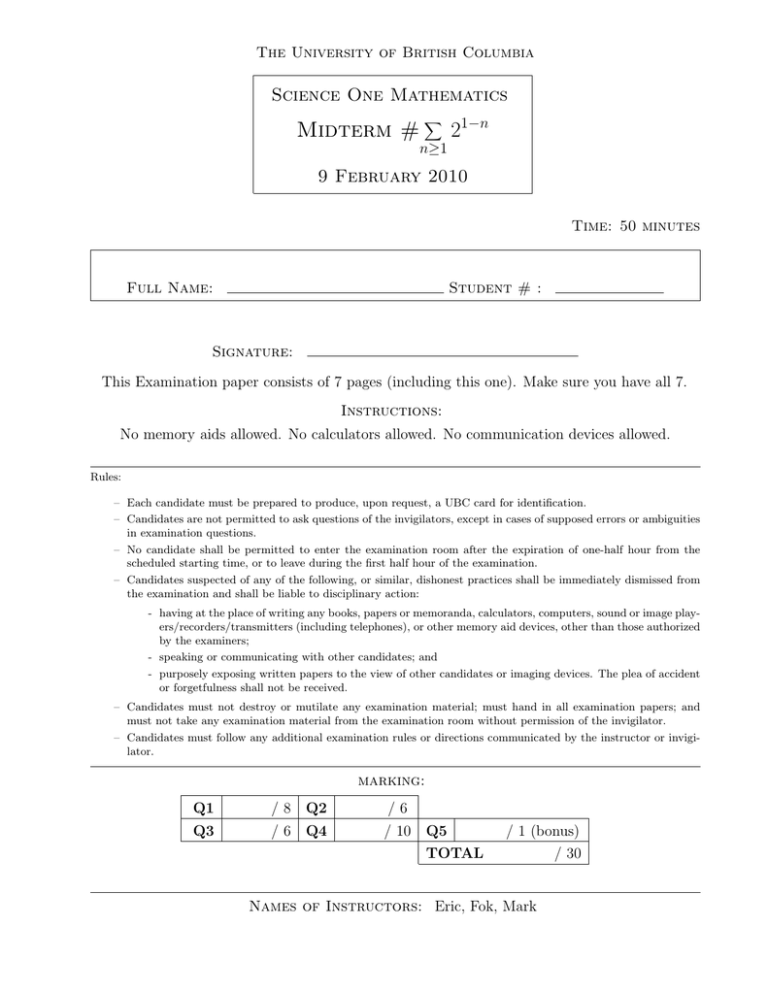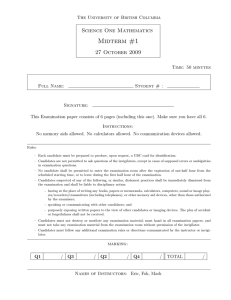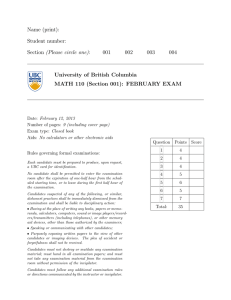2 Midterm # Science One Mathematics 9 February 2010
advertisement

The University of British Columbia
Science One Mathematics
Midterm #
X
21−n
n≥1
9 February 2010
Time: 50 minutes
Full Name:
Student # :
Signature:
This Examination paper consists of 7 pages (including this one). Make sure you have all 7.
Instructions:
No memory aids allowed. No calculators allowed. No communication devices allowed.
Rules:
– Each candidate must be prepared to produce, upon request, a UBC card for identification.
– Candidates are not permitted to ask questions of the invigilators, except in cases of supposed errors or ambiguities
in examination questions.
– No candidate shall be permitted to enter the examination room after the expiration of one-half hour from the
scheduled starting time, or to leave during the first half hour of the examination.
– Candidates suspected of any of the following, or similar, dishonest practices shall be immediately dismissed from
the examination and shall be liable to disciplinary action:
- having at the place of writing any books, papers or memoranda, calculators, computers, sound or image players/recorders/transmitters (including telephones), or other memory aid devices, other than those authorized
by the examiners;
- speaking or communicating with other candidates; and
- purposely exposing written papers to the view of other candidates or imaging devices. The plea of accident
or forgetfulness shall not be received.
– Candidates must not destroy or mutilate any examination material; must hand in all examination papers; and
must not take any examination material from the examination room without permission of the invigilator.
– Candidates must follow any additional examination rules or directions communicated by the instructor or invigilator.
marking:
Q1
/8
Q2
/6
Q3
/6
Q4
/ 10
Q5
/ 1 (bonus)
TOTAL
Names of Instructors: Eric, Fok, Mark
/ 30
Science One Mathematics — Midterm #
X
21−n — 9 February 2010 — p. 2 of 7
n≥1
Q1
[8 marks]
Consider the sequence {an }, defined recursively:
a1 = 1,
an+1 =
an
+ 1 for n ≥ 1.
3
(a) If {an } were to converge, what would it converge to?
(b) Prove that {an } converges.
Science One Mathematics — Midterm #
X
21−n — 9 February 2010 — p. 3 of 7
n≥1
Q2
[6 marks]
Determine whether the following series converge. Justify your answer.
√
(−1)n+5 n
(a)
n+1
n≥1
X
(b)
(2n − 1)(2n − 3) · · · (5)(3)
n≥1 (2n)(2n − 2)(2n − 4) · · · (4)(2)
X
Science One Mathematics — Midterm #
X
21−n — 9 February 2010 — p. 4 of 7
n≥1
Q3
[6 marks]
(a) State one of the two parts of the Fundamental Theorem of Calculus.
d
(b) Evaluate
dx
n
X
!
ix x
lim
sin
.
n→∞
n n
i=1
Science One Mathematics — Midterm #
X
21−n — 9 February 2010 — p. 5 of 7
n≥1
Q4
[10 marks]
(a) Find the Maclaurin series, and radius of convergence, for cos x.
1 − cos (x2 )
.
(b) Using your answer from part (a), or otherwise, evaluate lim
x→0 (1 − cos x)2
Science One Mathematics — Midterm #
X
21−n — 9 February 2010 — p. 6 of 7
n≥1
Q5
[1 bonus mark]
All convergent sequences are bounded, but not all bounded sequences are convergent. It is
true, however, that all bounded sequences have a convergent subsequence. (A subsequence is an
infinite sequence formed by deleting terms from a given sequence.) Explain how a convergent
subsequence may be constructed from a sequence which is bounded in the interval [0, 1], say.
(Hint: draw a picture.)
Science One Mathematics — Midterm #
X
21−n — 9 February 2010 — p. 7 of 7
n≥1
This page may be used for rough work. It will not be marked.
Q6



